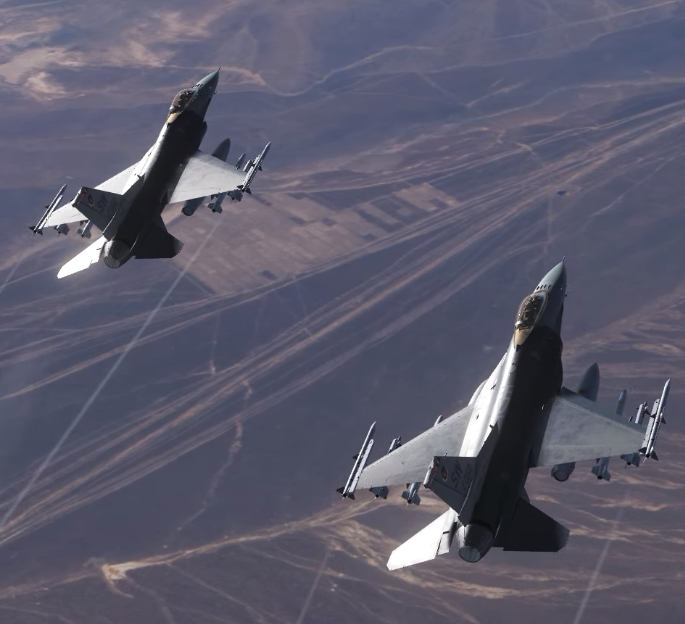Difference between revisions of "F-16C"
(→Planned) |
m (curing -> cueing) |
||
| Line 64: | Line 64: | ||
=Digital Systems Overview= | =Digital Systems Overview= | ||
---- | ---- | ||
| − | The F-16's avionics are interfaced with via two Multifunction Displays (MFDs), the Integrated Control Panel (ICP), the Data Entry Display (DED), and the head-up display (HUD)/helmet mounted | + | The F-16's avionics are interfaced with via two Multifunction Displays (MFDs), the Integrated Control Panel (ICP), the Data Entry Display (DED), and the head-up display (HUD)/helmet mounted cueing system (HMCS). The [[#HOTAS|hands on throttle and stick]] (HOTAS) system of the aircraft is also used for manipulating these systems, which is detailed in its own section and the sections relevant to specific HOTAS uses. |
==Sensor of Interest== | ==Sensor of Interest== | ||
Revision as of 13:41, 1 October 2019
The F-16C Fighting Falcon, often called the Viper, is a single-engine multi-role fighter jet airplane. The F-16 was created by General Dynamics (now Lockheed Martin) and operated by the United States Air Force and numerous other militaries. Despite the "F" (fighter) designation, it is designed for both air-to-air and air-to-ground missions and can use an array of weapons and sensors; built into the Viper is a 20mm cannon as well as a multifunction radar. The DCS F-16C models a Block 50 aircraft with the new F110-GE-129 engine and the Common Configuration Implementation Program (CCIP) avionics upgrade.
Contents
Weapons List
Implemented
Partially or fully implemented weapons of the F-16C Viper:
Planned
Weapons not yet implemented into the Viper:
- BDU-33, BDU-50LD/HD Training Bombs
- Mk-82LDGP, Mk-82AIR, Mk-84LDGP LGB
- CBU-87 CEM, CBU-97 SFW, CBU-103, CBU-105 Cluster Bombs
- 2.75” LAU-68, LAU-131 Rockets
- AIM-9L/M/P/X Sidewinder
- AIM-120B/C AMRAAM
- M61A1 20mm Cannon
- AGM-65D/G/H/K Maverick
- AGM-88C HARM
- GBU-10, GBU-12, GBU-24
- BRU-57/A
- GBU-31/A, GBU-38/B JDAM
- AGM-154A/B JSOW
- ALE-50 Towed Decoy
HOTAS
The Fighting Falcon's hands on throttle and stick (HOTAS) system is designed to allow the pilot to manipulate important avionics functions without releasing the hands from the throttle or control stick. This section will provide a summarized description of all HOTAS controls - detailed functionality will be described in other appropriate sections.
Control Stick
The control stick is a side-mounted stick used to manipulate the Flight Control System (FLCS), but also has numerous other HOTAS controls. The stick is mostly stationary and uses pressure sensitivity to be manipulated; it does, however, move a small physical distance.
- Trim Switch: The Trim Switch commands pitch (up/down) and roll (left/right) trim to the FLCS.
- Display Management Switch (DMS): The Display Management Switch (DMS) is used for avionics display manipulation and to assign the Sensor of Interest.
- Forward: Sensor of Interest assigned to HUD/HMCS
- Aft: Sensor of Interest assigned and cycles between the left and right MFDs
- Left: Cycles three configured quick access pages on the left MFD from right to left
- Right: Cycles three configured quick access pages on the right MFD from left to right
- Target Management Switch (TMS): The Target Management Switch (TMS) manipulates various sensors depending on what is the Sensor of Interest.
- Forward
- HUD SOI: When an A/G bomb is selected, designates SPI in DTOS/EO.
- FCR SOI: Commands Spotlight mode in RWS mode or commands BORE scan in ACM
- TGP SOI: Commands point track
- WPN SOI: Commands track
- HSD SOI: Designate active waypoint
- Aft
- HUD/FCR/WPN SOI: Target reject
- HSD SOI: Drop
- Left
- FCR SOI: Expanded data
- TGP/WPN SOI: Toggles seeker polarity
- Right
- FCR SOI: Steps bugged track in TWS or commands HUD scan in ACM
- TGP SOI: Commands area track
- Right, Long Press
- FCR SOI: Toggles TWS and RWS mode
- Forward
Digital Systems Overview
The F-16's avionics are interfaced with via two Multifunction Displays (MFDs), the Integrated Control Panel (ICP), the Data Entry Display (DED), and the head-up display (HUD)/helmet mounted cueing system (HMCS). The hands on throttle and stick (HOTAS) system of the aircraft is also used for manipulating these systems, which is detailed in its own section and the sections relevant to specific HOTAS uses.
Sensor of Interest
In the F-16, either the HUD/HMCS, the left MFD, or the right MFD is the designated Sensor of Interest, or "SOI." The SOI is used to dictate what HOTAS buttons do what function. The SOI is changed via the Display Management Switch (DMS) on the stick - forward will assign SOI to the HUD/HMCS while aft will cycle SOI between the left and right MFDs. If an MFD is SOI, a white border around it is displayed. If the HUD is SOI, an asterisk is put in the upper left corner.
Multifunction Displays
The F-16 has two Multifunction Displays (MFDs) on the left and right sides of the cockpit: each has 5 option select buttons (OSBs) on all four sides. The MFDs can display various software pages to manipulate the aircraft's avionics. Up to three pages per MFD can be selected on either MFD for quick access via pushbutton or HOTAS. These three pages always occupy the bottom center three pushbutton areas. In addition to these, a universal declutter (DCLT) button is provided, which will declutter the symbology depending on the page, and a SWAP button, which simply swaps the two MFD's quick access pages and selected page.
Selecting any of the three pushbuttons once they have already been selected prompts the main page menu. Any page can then be selected and will be filled at that pushbutton. That page can then be selected by either pressing the corresponding pushbutton or using the Display Management Switch (DMS) on the stick, and it will be highlighted. TMS LEFT and RIGHT respectively cycle the three quick access pages on the left/right MFDs in an outward fashion.

